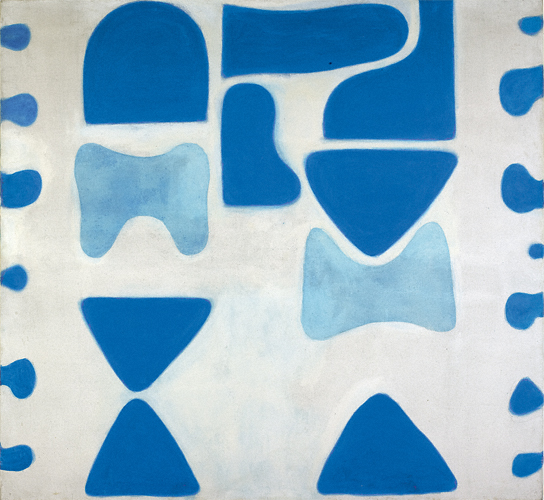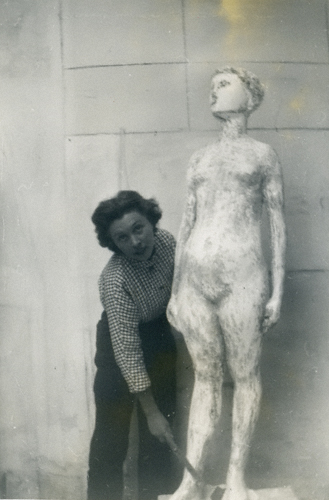1912
Hilda Mary Lucas, known as Mary, was born on 7 July, the daughter of William Temple Lucas and Sybil Wagstaff Thatcher. Her mother’s family owned Colthurst and Harding Ltd, a thriving paint manufacturing business outside Bristol, and she spent her childhood in a large Gothic manor in the village of Chew Magna, about ten miles from Bristol.
1930-2[?]
Attended the Bristol Municipal School of Art.
1932-4
Attended the Slade School of Fine Art (Mary Fedden was a fellow student).
1934-7
Attended the Royal Academy Schools, London (Sculpture School). Met fellow student William Scott, of whom she later recalled: ‘I remember so well, he had a baggy pair of flannel trousers with the bottoms all frayed, where he had cut them off. He used to buy his clothes in the Caledonian Market, off the Euston Road but there was something about him that remained in my mind.’
1935
Awarded a Landseer scholarship having been placed second for Two Models of Busts.
1936
Won the silver medal awarded by the Edward Stott Architectural Prize.
1937
Married William Scott on 19 May. The wedding took place at Chelsea Register Office with a small reception held afterwards at the Good Intent, a restaurant on the King’s Road. The same day, the Scotts travelled to Paris where William had secured a small job working on a ‘1937 Paris exhibition’ (very likely a job in the British pavilion of the Exposition Internationale des Arts et Techniques dans la Vie Moderne, which opened on 25 May 1937). The couple spent a week in Paris, staying at a small hotel in the students’ quarter near St Michel. On their return to England, they spent time in Cornwall and then Dorset.
1938-9
Lived and work in France and Italy. Mary and William met the English artist Geoffrey Nelson (also an ex-Slade student) in Pont-Aven, Brittany, and the three of them decided to set up a summer art school there.
1939
The Pont-Aven School of Painting opened in May; Mary taught Drawing and Sculpture. Among the first students was Bertha James, wife of Philip James, then keeper of the Victoria and Albert Museum Library.
On 29 August, Mary and William left France for England, where they stayed briefly with Mary’s aunt Hilda Cleminson in Devon before leaving for Ireland.
1940
Gave birth to her first son, Robert, on 5 January in Dublin. In March, the Scotts returned to England.
1941
With financial assistance from Mary’s family, the Scotts bought Elm Tree Cottage and Farm at Hallatrow in Somerset. Both Mary and William had studios in the outbuildings. A second son, James, was born in July.
1942
The Scotts decided to let Elm Tree Farm for a year and relocated to Cornwall. In July, William joined the army, at first in the Royal Ordnance Survey Corps and later the Royal Engineers.
1945
Had a joint exhibition of watercolours with William at the Leger Galleries in London.
1947
Mary taught modelling at the Bath Academy of Art, housed at Corsham Court in Wiltshire.
1950
Exhibited with other members of the Women’s International Art Club at their Jubilee Exhibition held at the R.B.A. Galleries in London.
1954
Mary’s sculpture of a penguin was unveiled at the newly founded Whitwick County Infants’ School, which was opened in November 1954. (It was a gift to the school from the Whitwick Granite Company and the Forest Rock Granite Company.)
1956
Two of Mary’s sculptures were included in the exhibition Contemporary Sculpture, held at the Hanover Gallery in London from July to September. The Times critic singled out her ‘elegant figurines’ for praise. (The Times, 29 July 1956) One of the sculptures was stolen from the gallery and, rather than this upsetting, Mary was delighted that somebody wanted it enough to take it. Nevertheless, from this point on, Mary stopped making her own work in order to support her husband and his career.
1957
Some of Mary’s bronze sculptures were shown at the Martha Jackson Gallery in New York.
1958
A bronze sculpture entered the collection of the Art Lending Service of the Museum of Modern Art, New York.
1963
William and Mary bought Bennett’s Hill Farm, a dairy and grazing farm in Coleford, a village in the Mendip Hills, close to Frome in Somerset.
1964
Spent much of the year in Berlin where William had been invited by the Ford Foundation to be an Artist in Residence.
1982
Suffered a severe stroke that left her paralysed down one side.
1989
On 28 December William died, having lived with Alzheimer’s disease for some years.
1997
Her work was shown alongside that of William in the exhibition William & Mary Scott: Related Drawings, Sculpture and Paintings, held at Enniskillen Castle from September to December.
1999
Mary died on 28 April at Bennett’s Hill Farm; she was buried next to William in Breandrum Cemetery, Enniskillen.


